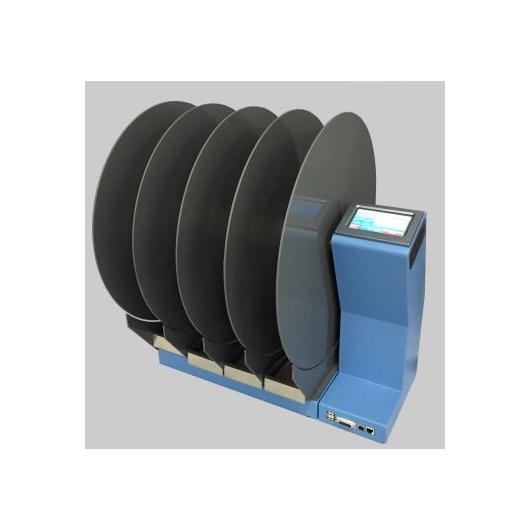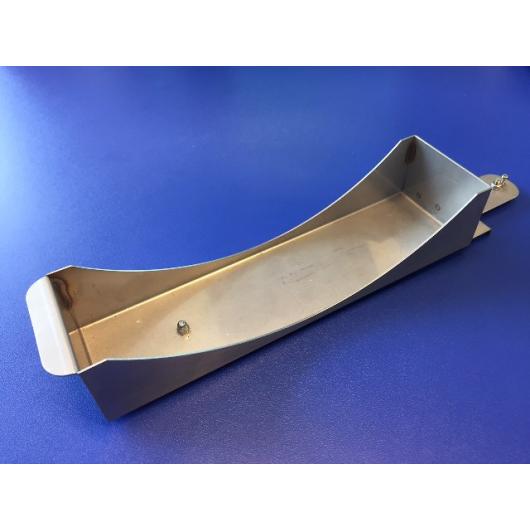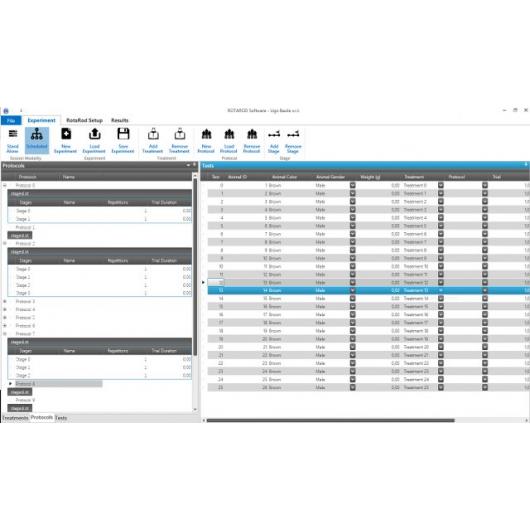




The 1st, original RotaRod for mice and rats
The “Rota-Rod” technique is essential in screening drugs potentially active, or having side effects, on motor coordination.
The RotaRod is a simple test to assess motor function and coordination in rodents. Motor coordination or fatigue can be evaluated by measuring the time the animal stays on a rotating rod before falling. The Rod can rotate at constant, accelerating, rocking (back and forth) or through complex acceleration/deceleration ramps, thanks to the included PC software XPad.
The Ugo Basile RotaRod is the 1st and original, invented after the Dunham and Miya method (1957) and today has more than 6,200 citations in the literature. Ugo Basile Rotarod comes in a mouse 5-lane version, in a Rat 4-lane version and in a “Obese Rat” version, plus Rod Adapters to enlarge the diameter of the rod.
The rotarod test, invented by Dunham and Miya (1957) and transformed into a science-grade device by Ugo Basile, is one of the oldest used in assessing the effects of a drug on animal behavior. Today it is obviously used in phenotyping and not only in drug screening.
Drugs (e.g. benzodiazepines) or specific phenotypes alter neuromuscular coordination and hence the time that the mouse or rat remains on the rotating rod. Multiple animals can be tested at the same time and several protocols exist to train and assess the motory coordination through the falling time.
The output results include for each lane:
- Time elapsed
- Revolutions
- Distance
- Speed
- Rotating mode
Applications of RotaRod
The RotaRod test is commonly used in combination with other motor tests, such as grip strength and hanging test to measure, motor function, coordination and balance. The test starts with a training trial with the animals placed on the rod rotating at the lowest speed. A time threshold (e.g. 1 minute) is set, below which the animal is immediately put back on the RotaRod until it stays on the rod for the threshold time.
After training, the real trials start and the latency to fall as well as the other parameters (see above) are recorded. The classic test was run at constant speed, but already in the ‘60s (Jones and Roberts, 1968), the advantages of using accelerating modes were shown, through training reduction, increased sensitivity and statistical significance.
The test is used to test motor deficits in the most common animal models of Parkinson’s, ALS, Huntington’s disease, multiple sclerosis, brain injury and many more.
Features&benefits of RotaRod
- Constant, rocking, accelerating and complex accelerating ramps: flexibility for performing virtually all types of motor function and coordination behavioral experiments
- Mouse-Rat combination package: The same device cannot be used effectively (think of cleaning) or rats and mice without risk of confounding factors, so a highly discounted package is available for those that buy the two models.
- Optional Rod enlarger allows to test different animal models and also to vary the test difficulty without acting on the speed or mode
- Speed adjustable from 3 to 80 RPMs and multiple modes (constant, rocking, accelerating, complex accelerating ramps) allows for a very broad range of animal models and experimental settings
- Control unit and USB key saving: no need to connect a PC
- Automatic conversion of data into CSV files for the USB stick: possibility to open files in Excel
- PC software: possibility to populate your vivarium of animals and to build complex temperature ramps
- An electronic unit with touch screen to set all parameters and save data
- USB port to save data and export them in CSV files
- A PC software to build custom rotation ramps and populate your animal vivarium
- TTL input/outputs for trip box status and start/stop of the test
- COM port for maintenance purposes
- Ethernet port for support and maintenance (to be used at the factory only)
To find RotaRod citations go to UGO Basile website [here].
N. W. Dunham, T. S. Miya, 1957, "A note on a simple apparatus for detecting neurological deficit in rats and mice", PubMed
B. J. Jones, D. J. Roberts, 1968, "The quantitative measurement of motor inco-ordination in naive mice using an accelerating rotarod", Journal of Pharmacy and Pharmacology
Cora R. von Collenberg et. al., 2020, "Correction: An essential role of the mouse synapse-associated protein Syap1 in circuits for spontaneous motor activity and rotarod balance", Biol Open.
Haiwang Ji et. al., 2022, "A Mouse Model of Cancer Induced Bone Pain: From Pain to Movement", Front Behav Neurosci.
Stefania Forner et. al., 2021, "Systematic phenotyping and characterization of the 5xFAD mouse model of Alzheimer’s disease", Nature
Moritz Möller et. al., 2022 "The Role of AlphαSynuclein in Mouse Models of Acute, Inflammatory and Neuropathic Pain", Cells





